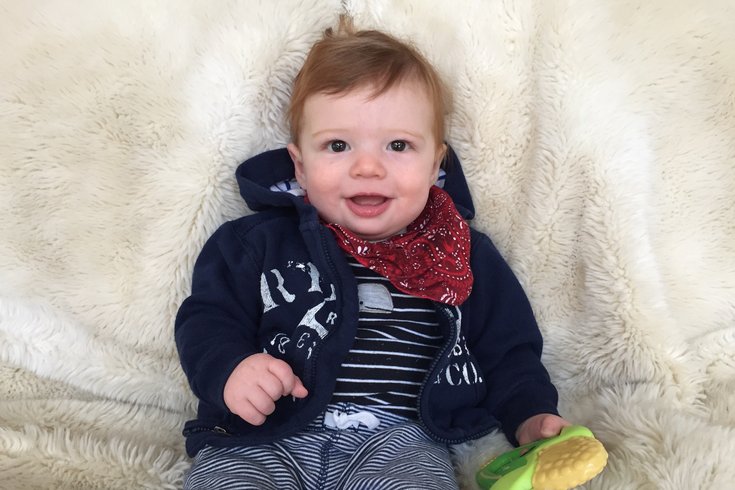
April 11, 2017
 Katie Gagnon/for PhillyVoice
Katie Gagnon/for PhillyVoice
Two of Katie's tips for a teething baby are to have lots of bibs and some teething toys, like the one Killian is holding.
Killian started showing signs of teething around 3 months old, which really surprised me. He was just out of his newborn stage; I did not think teething would be occurring yet! But when he started drooling like crazy and putting everything in his mouth, my mom announced that teething had begun. It was not long after that I noticed his bottom gum was a little red and swollen and then later two little teeth started pushing up. Those teeth have not yet broken the surface, but they feel more prominent to the touch, which is probably why Killian spends a lot of time these days with his tongue out, rubbing it along the bottom of his mouth.
Teething is an important developmental marker for little ones, albeit one that is not very fun for baby or parents. Most babies start teething around 4 to 6 months old, and it is usually the bottom two front teeth that make their appearance first. The symptoms of teething include drooling; swollen, sensitive gums; coughing (from increased saliva); biting; refusing to eat; pulling on ears; grabbing at cheeks; fussiness; and sleep problems. Of course, every baby is different and may not display all or even most of these signs. With Killian, we have seen lots of drool, coughing and infrequent fussiness accompanied by his little hands holding his precious little cheeks.
For my baby, teething is not an everyday trouble. It seems that every few days, he is cranky from the discomfort. I keep hoping that Killian’s bottom two front teeth will break through and provide him with some relief, but, of course, once those come in, we still have a mouthful to go! My friends with older babies tell me that molars are even worse than the first baby teeth. It is so difficult as a mama to know that your little one is in pain.
Based on guidance from other parents and my pediatrician, I utilize several techniques to soothe my teething baby boy. Here are some tips that have been working for my baby and may work for yours:
1. Numb the gums: Killian really likes the feeling of cold on his gums. Put your baby’s favorite toy or a damp washcloth in the fridge to cool it and then give to your baby to provide him with some numbing relief. Like everything your baby comes in contact with, make sure it is age-appropriate, BPA-free, sanitized and nontoxic and never leave him unattended. There are differing opinions about whether or not to use a frozen teething ring; check with your pediatrician first.
2. Buy lots of bibs: Killian drools so much that he will soak through his shirts in five minutes flat. Rather than change his tops throughout the day, I rotate through bibs. It is a timesaver for this mama, keeps baby boy’s chest clean and dry and helps cut down on laundry.
3. Turn to teething toys: If your little one is like mine, everything he can get his hands on is going into his mouth. Surround your baby with toys that are specifically designed to help his teething. Killian loves his John Deere vibrating corn teether and Chewbeads teething necklace, which I wear.
4. Everyone loves a massage: Massaging your little one’s gums with a clean finger will provide counter pressure that your baby should find soothing. You can do this as often as you and baby like. I enjoy doing this with Killian because it is a direct way that I can attempt to soothe my precious baby’s pain while giving him some sweet cuddles.
5. Try a little Tylenol: There have been a few occasions when Killian seems to be in tremendous pain and his teething is disrupting his sleeping. At those times, I have given him Infants’ Tylenol®. I use this as a measure of last resort to help relieve my baby’s pain and am careful not to medicate him too often.
6. Talk to your pediatrician: People have recommended that we try numbing gels and amber teething necklaces, both of which many pediatricians advise against. I am always seeking guidance and advice from other parents, but my main source of information is Killian’s doctor. Talking to your medical expert is always best!
What are your tips for soothing a teething baby? Share with me in the comments section below or tweet me @ThePhillyVoice and @KathleenEGagnon.